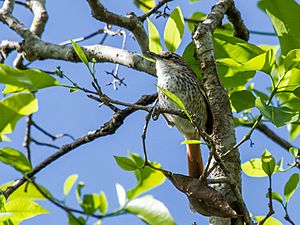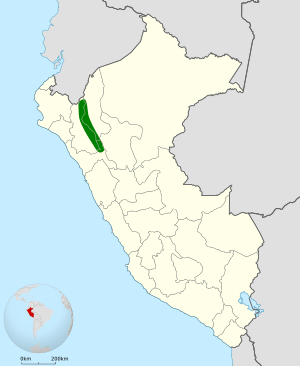Chinchipe spinetail facts for kids
Quick facts for kids Chinchipe spinetail |
|
|---|---|
 |
|
| Conservation status | |
| Scientific classification | |
| Genus: |
Synallaxis
|
| Species: |
chinchipensis
|
 |
|
The Chinchipe spinetail (Synallaxis chinchipensis) is a small bird that lives only in Peru. It belongs to the Furnariidae family, also known as ovenbirds. This bird is special because it's found nowhere else in the world!
Contents
About This Bird's Name
For a long time, the Chinchipe spinetail was thought to be a type of necklaced spinetail. But scientists studied them closely. They looked at how the birds looked, how they sang, and their family tree.
Based on this new information, experts decided in 2021 that the Chinchipe spinetail was different enough. So, it became its own unique species!
What the Chinchipe Spinetail Looks Like
Both male and female Chinchipe spinetails look very similar. The top of their head and their back are a greenish-olive color. Their lower back, called the rump, is a cinnamon brown.
Their lower sides are grayish-brown. They have a long, brown tail with reddish feathers on the outside. You might notice a pale "eyebrow" stripe above their eyes.
They also have a white throat. Their upper chest has small brown spots. This is a small bird, usually about 11 to 13 centimeters (4.3 to 5.1 inches) long. Scientists have not yet described what young Chinchipe spinetails look like.
Where It Lives and Its Home
The Chinchipe spinetail lives only in the northwestern part of Peru. You can find it near the Río Marañón and Río Chinchipe rivers.
It likes to live in scrublands. It also lives at the edges of forests where trees lose their leaves. These birds usually live at elevations between 400 and 600 meters (1,300 to 2,000 feet) above sea level.
How It Behaves and Eats
The Chinchipe spinetail mainly eats arthropods. These are small creatures like insects and spiders. It also eats their young, called larvae.
This bird usually looks for food close to the ground. It searches about 1 to 2 meters (3 to 7 feet) high. It picks food from moss, leaves, and small branches.
Chinchipe spinetails often feed in pairs. Sometimes, they join groups with other types of birds. These birds do not migrate, meaning they stay in the same area all year. Scientists are still learning about their breeding habits.
Its Conservation Status
Scientists have not counted exactly how many Chinchipe spinetails there are. However, they believe the number of these birds is stable.
Because of this, BirdLife International has rated the species as "Least Concern." This means it is not currently in danger of disappearing. The bird seems to be able to live even if its habitat changes a little.
See also
 In Spanish: Pijuí de Chinchipe para niños
In Spanish: Pijuí de Chinchipe para niños


